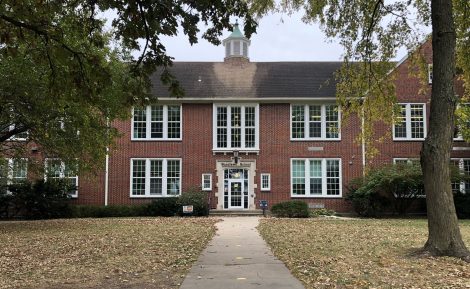Lawrence students calculate their cafeteria’s waste, propose solution

photo by: Richard Gwin
From left, South Middle School students Amelia Vasquez and Lisa Yang, both 14, talk about their proposal to replace the use of flat trays and single-use plastic containers with sectioned trays, Thursday, June 2, 2016, at South Middle School.
When South Middle School student Amelia Vasquez got her school lunch, what she noticed most wasn’t the food. What she saw was that each main dish and each side was individually served in foam, plastic or paper containers and that after every lunch period the cafeteria trashcans were full of them.
“Because it’s not directly affecting most of us, we set it aside,” Vasquez said. But Vasquez didn’t want to brush off the thought.
She and a classmate, Lisa Yang, started asking questions: to cafeteria staff, food service directors in other districts and, eventually, Lawrence school district leaders. What they ended up with was a potential solution: instead of using flat trays that necessitate individual containers for food, they proposed using sectioned trays instead.
“By using trays with sections in them, we wouldn’t have to use all the disposable plastics,” Yang said. “And people could just put their food in there and dump out their trays when they’re done eating.”

photo by: Richard Gwin
From left, South Middle School students Amelia Vasquez and Lisa Yang, both 14, talk about their proposal to replace the use of flat trays and single-use plastic containers with sectioned trays, Thursday, June 2, 2016, at South Middle School.
As part of a school project, Vasquez and Yang researched the topic and formally proposed their idea to the Lawrence school board. They calculated that the South cafeteria uses more than 250,000 single-use containers or plastic bags in a school year, costing the school anywhere from $100 to $300 per month, Vasquez said.
The students concluded that by switching to sectioned trays and eliminating the use of single-use containers and bags, the district could not only drastically reduce the waste it was producing but also save money.
“There’s really no good solution to the world’s plastic problem,” Vasquez said, noting that they also looked into a wood-based tray, but ultimately picked the sectioned, polypropylene tray, which they said had fewer harmful chemicals than some other plastic materials.
Vasquez and Yang presented their research and proposal to switch to sectioned trays to the school board at its last meeting. The students shared a lot of the figures they estimated, including that it would cost about $2,500 to buy sectioned trays for every student at South, a purchase they said would pay for itself after about 1.5 years.
“We were able to estimate many figures, like that one, but we will never be able to estimate the future health problems and environmental destruction our schools alone will cause, until it’s too late,” Vasquez told the board.
The “community activism” project was part of the gifted program at South, and Vasquez and Yang’s project was one of four that students worked on during the spring semester. The three other projects dealt with Wi-Fi access, distracted driving and financial responsibility, said Ashley Beason-Manes, the gifted education facilitator at South.
“While they are very bright and high-achieving students, I hoped that through doing a project like this, they could see the power they have as kids and as citizens and activists to create change,” Beason-Manes said.
Beason-Manes said all the research for the cafeteria project was done by Vasquez and Yang, and they put in countless hours both during and outside of school.
“They were determined from the beginning,” Beason-Manes said. “Honestly, I established a framework, but then was able to turn it over to them each day and saw them grow in their empowerment, their knowledge, their passion and understanding for the topic.”
As part of their project, Vasquez and Yang also created a petition in support of the changeover to sectioned trays. More than 200 staff, students and parents at South signed the petition, which they also delivered to the school board. But Vasquez said creating the petition and presenting it to others was more about education.
“We also really want to tell people about our project,” Vasquez said. “Because sure it would be great to stop using those trays and so many plastic things, but it could be a lot better if we tell people why we’re doing it.”
Although the students — who will both attend Lawrence High School next school year — focused their project on changes to the cafeteria at South, they see it as a change that could be made districtwide.
“We just started with South since that was our school and we wanted to experiment with it and have a good sample space for how much it would cost and everything,” Yang said. “What we want to see is having all the cafeterias use polypropylene trays with sections in them in place of the disposable plastics.”
District food services officials were not available on Friday, but district spokeswoman Julie Boyle said the director will review the students’ request next week. Members of the school board also told the students they would consider their proposal, and Vasquez and Yang say they plan to follow up with board members ahead of their next meeting on June 13.







